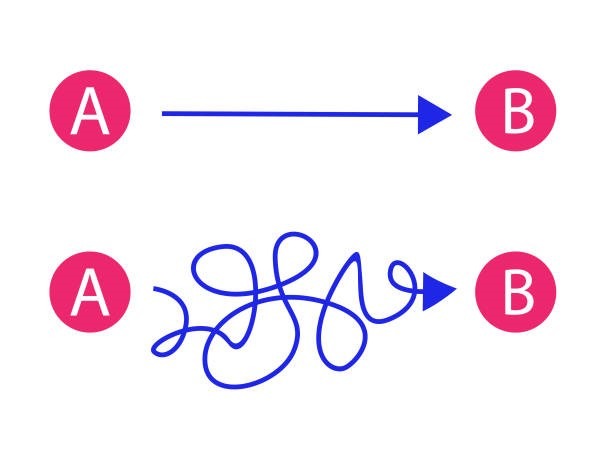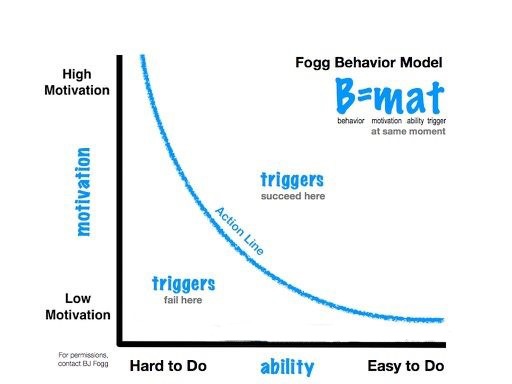
How To Make The Customer Journey Enjoyable
It’s not about the destination, it’s about the journey.
Or so they say anyway…
And for the customer, it actually is all about the journey which means as a business owner/marketer, it’s about the journey for you – the customer journey that is.
Customer journeys can look like either one of these graphics:

Out of 100 customers, you may get anywhere from 1-10 people who go from A to B in a straight line.
The rest will require nurturing, information and a level of trust to part with their money or even just to sign up, all of which a good marketing agency in London will be able to help you do!
How To Increase Enjoyment
There are 3 components that you can focus on to start off with:
- Reduce friction
- Provide all the answers to all the questions
- Increase buyer motivation graduall
We’ll talk about all 3 reciprocally here…
There’s a fantastic model that was researched and created by B.J Fogg called the B.J Fogg behaviour model which looks like this:

The above looks way more complicated than it sounds by the way. It can be broken down into two components:
- Higher the motivation, the less action required and the lower the motivation, the more action required
- The easier it is, the easier to take action and the harder it is, the harder it is to take action
This graph encapsulates both the reduce friction and increase motivation gradually.
If you’re product/service is harder to use and there are multiple hoops to jump through that are time-consuming then you will see huge drop-offs with people giving up.
And if the motivation to buy your product/service is not high then people will forget and struggle with reluctant-purchasing.
So, what about point two? The provide answers to all questions point?
Well, to increase motivation in a customer, you can help them with increasing their knowledge of your product/service by answering their questions.
When a customer has all the answers to their objections then they’re further down the funnel, their trust in your product/service has increased and they’re not left with any doubts.
This also relates to the reduce friction point because most of the friction caused in the buying process is from people not having their questions answered on the website/product page.
You may even find that people who have all the answers questioned are willing to jump through more hoops because they’re motivated to buy the product, their chances of buying has increased substantially!

Ecommerce Case Study Example
Let’s take an ecommerce store selling books that are struggling with sales and has seen a drop off in sales in recent months.
They’ve noticed huge numbers of people add products to their basket but 80% are dropping off before they make a purchase.
We go through the customer journey ourselves and notice that the checkout process requires the customer to fill out 10 fields of data.
BIG MISTAKE!
Studies show that reducing your number of fields from 11 to 4 can boost conversions by 120%.
So, we go ahead and reduce our number of fields to the absolute essentials – name and email.
After this step, they get taken to the Paypal payment page and in two-clicks, they’ve purchased the product and received confirmation that it will be with them next-day.
In all honesty, this customer journey transformation is too simple so let’s think of other ways we can improve it.
Let’s say it has the following problems:
- People are asking multiple questions about the book
- The company is receiving a return rate of 40% each week
We can already guess the problem that is arising here with the above two points – lack of knowledge for the customer!
If you’re receiving an unusual amount of questions about your product/service then you’re not providing the right amount of information somewhere in the buying process.
So, we look at the product page for the book and notice there is just one image of the book that is slightly pixelated and there is no product description for the book.
We decide that the book needs clear pictures, both of the front and back of the book, with a sneak peek into the chapter list. We then provide a brief 100 word summary of what the book is about.
This conclusion was drawn from the fact that people were intrigued by the book cover at first but wanted to know what the book was about – a valid question, right?
Now, we’ve implemented this and after a few weeks, we notice that more people are spending time on the page and the description has piqued their curiosity so they go through the smooth checkout process we set up earlier.
Voila!
Conclusion
Always think about the individual(s) buying your product/service and testing their shoes to get accustomed to your own service.
That’s why many customers know the product better than the people making it who don’t use the product.
If you don’t use what you’re selling then you’re not going to be the most informed person about it – your customer is and it’s then open to their interpretation which gives you no control over the customer journey!























